#chronic hepatitis B
Explore tagged Tumblr posts
Text
youtube
#HBV#HIV-1#hepatic flare#antiretroviral therapy#HBsAg seroclearance#HBV/HIV co-infection#immune reconstitution#liver enzymes#viral clearance#chronic hepatitis B#HIV treatment outcomes#liver health#ART-induced immune response#infectious diseases#hepatology#co-infection management#liver function monitoring#viral hepatitis#immune response dynamics#public health.#Youtube
1 note
·
View note
Text
Understanding Hepatitis B: Symptoms, Diagnosis, and Treatment
Hepatitis B is a significant global health issue that demands attention due to its widespread impact on millions of people. The hepatitis B virus (HBV) targets the liver, leading to both acute and chronic conditions, and its consequences can be severe, including cirrhosis, liver cancer, and death. This text offers a comprehensive understanding of hepatitis B by delving into its symptoms,…
#chronic hepatitis#hepatitis B#hepatitis B symptoms#hepatitis B treatment#liver health#viral infection
0 notes
Text
World Hepatitis Day 2024: Raising Awareness and Promoting Action on Hepatitis
Annual Observation on July 28 Aims to Highlight the Dangers of Hepatitis and Encourage Testing, Treatment, and Vaccination Dr. Amiya Ranjan Specialist, Department of Gastroenterology, Tata Main Hospital World Hepatitis Day, held on July 28, seeks to increase awareness of viral hepatitis and its associated health risks. This date marks the birthday of Dr. Baruch Blumberg, the Nobel laureate who…
#फोकस#chronic hepatitis B and C#Dr. Baruch Blumberg#hepatitis B discovery#hepatitis prevention#hepatitis testing#hepatitis treatment#liver inflammation#spotlight#viral hepatitis awareness#WHO hepatitis study#World Hepatitis Day
0 notes
Text
Types, Symptoms and Risk factors of Pancreatic Cancer
Pancreatic cancer is a type of cancer that originates in the pancreas, a glandular organ located behind the stomach. The pancreas plays a crucial role in digestion and blood sugar regulation by producing enzymes and hormones like insulin.

Pancreatic cancer typically starts in the cells lining the ducts of the pancreas, which are responsible for carrying digestive juices. Over time, these cancerous cells can grow and spread to other parts of the pancreas or to nearby organs and tissues, as well as to distant parts of the body (metastasis).
Types of Pancreatic Cancer:
Exocrine Pancreatic Cancer: The most common type, accounting for about 95% of cases, originates in the exocrine cells that produce digestive enzymes. The most common form of exocrine pancreatic cancer is adenocarcinoma.
Endocrine Pancreatic Cancer (Pancreatic Neuroendocrine Tumors): Less common, these tumors develop in the endocrine cells of the pancreas, which produce hormones like insulin and glucagon. These tumors are often less aggressive than exocrine pancreatic cancer.
Symptoms of Pancreatic Cancer:
Abdominal pain: Typically starts in the upper abdomen and may radiate to the back.
Jaundice: Yellowing of the skin and eyes, often accompanied by dark urine and pale stools.
Unexplained weight loss: Significant weight loss without changes in diet or exercise.
Loss of appetite:Decreased interest in eating, often accompanied by nausea and vomiting.
New-onset diabetes: Diabetes that develops suddenly without a clear cause.
Digestive problems: Changes in bowel habits, indigestion, or difficulty digesting fatty foods.
Risk Factors for Pancreatic Cancer:
Age:Risk increases with age, with the majority of cases occurring in people over 60.
Smoking:Cigarette smoking is one of the most significant risk factors for pancreatic cancer.
Family history: Having close relatives with pancreatic cancer increases the risk.
Chronic pancreatitis: Long-term inflammation of the pancreas raises the risk.
Obesity: Being overweight or obese increases the likelihood of developing pancreatic cancer.
Diabetes: Chronic diabetes may slightly increase the risk of pancreatic cancer.
Dietary Factors: High intake of red meat, processed meats, and saturated fats, as well as low intake of fruits and vegetables, may contribute to an increased risk
Diagnosis and Treatment:
Diagnosis:Typically involves imaging tests such as CT scans, MRI, or endoscopic ultrasound, as well as biopsy for confirmation.
Treatment: Options include surgery, chemotherapy, radiation therapy, targeted therapy, immunotherapy, and clinical trials.
Prognosis:Pancreatic cancer is often diagnosed at an advanced stage, which makes it challenging to treat. The prognosis varies depending on the stage of the cancer, with early detection associated with better outcomes.
Pancreatic cancer is often diagnosed at an advanced stage, making it one of the deadliest forms of cancer. However, advancements in the treatment of pancreatic cancer in Bangalore and early detection strategies offer hope for improved outcomes and better quality of life for patients. Regular screening for those at high risk and awareness of symptoms are crucial for early detection and treatment.
#Pancreatic cancer treatment in Bangalore#Hepatitis b treatment in Bangalore#Chronic Hepatitis b treatment in Bangalore#Jaundice treatment in Bangalore#livercare#cancer#pancreatic tumor
0 notes
Text

Hepatitis in Pediatric Patients:
Children represent a vulnerable demographic susceptible to hepatitis, displaying unique patterns of transmission, clinical manifestations, and long-term consequences. Hepatitis A, primarily spread through fecal-oral contamination of food and water, poses a significant threat to children, often presenting as acute illness characterized by jaundice, fatigue, abdominal discomfort, and nausea. Conversely, hepatitis B, typically transmitted from mother to child during childbirth or through blood exposure, presents distinctive challenges in pediatric healthcare, necessitating timely vaccination and careful screening of high-risk infants. The evolving landscape of pediatric hepatitis highlights the critical role of comprehensive vaccination programs, early detection, and multidisciplinary care to mitigate disease impact and prevent long-term complications in children.
Hepatitis in the Adult Population:
Adults comprise a diverse group affected by hepatitis, with hepatitis B and C emerging as prominent global concerns, particularly among high-risk groups like injection drug users, healthcare professionals, and individuals with underlying health conditions. Chronic hepatitis B, prevalent in a substantial portion of adults, underscores the importance of targeted screening, early detection, and prompt initiation of antiviral therapy to prevent disease progression and reduce the risk of liver cirrhosis and cancer. Similarly, hepatitis C, once a formidable challenge with limited treatment options, has seen a significant transformation with the introduction of direct-acting antiviral agents, offering cure rates exceeding 95% and reshaping the landscape of hepatitis management in adults. However, addressing disparities in access to screening, diagnosis, and treatment remains a critical challenge, requiring concerted efforts to improve healthcare delivery and outcomes globally.
Diagnosis and Management:
The diagnosis of hepatitis requires a systematic approach involving clinical assessment, laboratory tests, imaging studies, and histopathological examination to determine the underlying cause, assess disease severity, and guide treatment decisions. Blood tests, including serological markers and viral load assays, are essential for distinguishing between acute and chronic hepatitis, identifying viral strains, and monitoring treatment response. Imaging techniques such as ultrasound, CT scans, and MRI provide valuable information on liver structure, blood flow, and the presence of complications such as cirrhosis and liver cancer. Although invasive, liver biopsy remains valuable in certain cases, offering histological confirmation of the diagnosis and guiding treatment strategies.
Treatment options for hepatitis encompass a variety of pharmacological interventions, including antiviral drugs, immunomodulatory therapy, and supportive care measures to alleviate symptoms and promote liver health. In acute hepatitis, conservative management with rest, hydration, and dietary adjustments is often sufficient, with close monitoring of liver function and symptoms. Chronic hepatitis requires a proactive approach aimed at achieving sustained viral suppression, halting disease progression, and reducing the risk of complications. Antiviral medications targeting specific viral enzymes have revolutionized treatment, offering high efficacy and shorter durations compared to conventional therapies. Additionally, immunomodulatory agents play a role in managing autoimmune hepatitis and hepatitis associated with systemic conditions.
Early diagnosis and management of hepatitis is possible by undergoing a regular full body health checkup at a good hospital.
#regular health checkups#full body health checkup#hepatitis#hepatitis A#hepatitis B#hepatitis C#pediatric hepatitis#chronic hepatitis#blood tests#CT scans#MRI scans#liver biopsy#liver health#acute hepatitis#antiviral drugs
0 notes
Text
Chronic Glomerulonephritis
Chronic Glomerulonephritis are a group of disorders in which the glomeruli are predominantly involved due to an inflammatory process which does not abate.
0 notes
Text
My name is Montaser, and I live in Gaza, where we face an extremely difficult life due to the ongoing war. With each escalation, my family is forced to relocate in search of safety.

We have moved from Gaza to Nuseirat Camp, then to Khan Yunis, then to Rafah, and finally to Al-Zawayda.
My family consists of 14 members, including elderly individuals, sick individuals, and children.

We live in a small tent from 7 Oct 2023 till now, a tent that barely fits all of us.

Life here has become unbearable. We suffer from a severe shortage of water, food, and medicine. Every day is a struggle to survive. We have reached the point where we have to drink seawater because we have no other choice. We truly have a water crisis; water only reaches us once a week, and due to the heavy crowding, we are unable to secure enough water.

My mother and father both suffer from high blood pressure and need regular medication. I suffer from chronic digestive problems and also hepatitis.

I am writing to you today to ask for help. We are in desperate need of your support to provide the basic necessities for my family. Every donation, no matter how small, can make a significant difference in our lives. Through your support, we hope to secure clean water, food, and medicine for my family members.
Thank you for your time and generosity. We hope that our plea reaches you and that you find it in your hearts to offer assistance. Every donation makes a difference and helps save lives.
May God bless you all.
#all eyes on palestine#free gaza#free palestine#gaza#gaza genocide#gaza strip#gazaunderattack#gofundme#palestine genocide#palestinian genocide
1K notes
·
View notes
Text
Autism Made in USA
Over the past few decades, the dramatic increase in autism spectrum disorders (ASD), now diagnosed in 1 in every 36 children, has often been attributed to improved definitions for ASD and diagnostic tools. However, a closer look at government statistics reveals alarming trends in children’s health that go far beyond better diagnostics. Since the early 1990s, there have been staggering increases in several chronic conditions: ADHD rates have risen by 890 percent, autism diagnoses by 2,094 percent, bipolar disease in youth by 10,833 percent, and celiac disease by 1,011 percent. These numbers beg the question—what has fundamentally changed in our children’s health over the past three decades?
Despite these concerning trends, our culture continues to elevate science as the ultimate authority on health and reality, often dismissing common sense, reason, and direct empirical observation. Ironically, physicians rely on patients to describe their symptoms—a testament to the importance of individual observations—while federal health agencies and influential organizations like the American Academy of Pediatrics dismiss environmental factors in favor of subjective theories, such as genetic predispositions or chemical brain imbalances as the root causes for the majority of mental and behavioral disorders in children.
This reliance on ideology over empirical scrutiny extends to vaccine development, where standard double-blind placebo trials, the gold standard for FDA drug approval, are glaringly absent. Vaccines such as the hepatitis B shot for infants and the HPV vaccine Gardasil for adolescents have been approved with minimal scientific rigor, yet they are heavily promoted and, in many cases, mandated.
The media compounds the issue by amplifying the official narrative while systematically excluding dissenting voices. This failure of transparency has allowed federal health agencies like the CDC, NIAID, and HHS to evade accountability. These institutions, which should safeguard public health, have instead become ideologically and politically captured by private interests. Their close ties to pharmaceutical companies have led to the approval of insufficiently tested vaccines, the pathologization of normal childhood behaviors, and the delivery of subpar healthcare—all at a staggering cost of $5 trillion annually.
https://www.globalresearch.ca/autism-made-usa/5874947
21 notes
·
View notes
Text
Bite
Tw: mentions of abuse
Human bite
"Human bites can occur directly or indirectly. Biting among young children is the most common type of bite. But you can also get an indirect injury if your fist makes contact with another person’s mouth. Although most human bites aren’t serious, you should have any bite that breaks the surface of your skin looked at due to the risk of infection."
Are human bites dangerous?
"Human bite wounds can occasionally be more dangerous than you’d expect. Germs in the saliva of human mouths can increase your risk of infection. A wound may appear minor, but a bacterial infection can lead to more severe infections and complications."
You’ll likely experience symptoms at the site of your injury, including:
Pain.
Tenderness.
Bleeding.
Swelling.
If an infection develops in the bite wound, you may have:
Intense pain and swelling.
Pus around your wound.
Redness around your wound.
Skin that feels warm to the touch.
Fever, chills or a general sense of feeling unwell.
A bite on your finger can sometimes damage tendons and/or nerves. Signs include:
Loss of feeling in your fingertip.
Trouble bending or fully straightening your finger.
Via source
With respect to Shelby's first stream, and this docs
According to Shelby:
•Her ex-partner would bite her arms until they bruised, then press on them to cause her more pain.
•He never cleaned his house, even if he spilled/dropped something.
Bruised
You say?
We have the most obvious point that Shelby use to where clothing that revealed her arms and legs hence showing no signs of injury what so ever
Make up, although a powerfull source to hide bruises, can never hide the lumps and bumps or disfigured structure of the damaged area.
Also
As mentioned above, human bites cause infection, sometimes chronic enough to cause death. It is a fact, a human bite may be more dangerous than an animal bite.
Dieses that spring from human bites are:
HIV/ AIDS
Hepatitis B
Hepatitis C
Forget about bruises being visible
Has shubble ever considered going to the hospital? L
Another thing I wanna point out is that her ex alleged to have very unhygienic standards, refrence to the second point mentioned.
So the chances of Shelby developing a chronic infection due to these are higher than it may seem.
So why didn't she go to the hospital ?
Why didn't we get to hear her go to a hospital?
Yk like the responsible adult she is
{Probably bc the aligations are false}
#wilbur support squad#wilbur soot support#dont like dont interact#wss#wilbur soot#mental health matters#mental health#shelby shubble#sss dni#tw
25 notes
·
View notes
Text
Bisexuality, Biphobia, and Health
This is going to be a quick run-through, but no doubt I'll return to this topic in future posts. For now:
The following are the statistically significant (i.e. strong evidence) findings of Horn and Swartz, 2019, “A Comparative Analysis of Lifetime Medical Conditions and Infectious Diseases by Sexual Identity, Attraction, and Concordance among Women: Results from a National U.S. Survey”:
Bisexual women reported higher rates of poverty (26.4%) than homosexual (18.9%) or heterosexual women (15.7%)
Bisexual women reported higher rates of asthma (18%) than homosexual (16.5%) or heterosexual women (10.8%)
Bisexual women reported higher rates of hepatitis B/C and were more likely to report having had an STI in the last 12 months than homosexual or heterosexual women
Bisexual women were more likely to report having had any form of cancer than heterosexual women
The 2016 “Comparison of Health and Health Risk Factors Between Lesbian, Gay, and Bisexual Adults and Heterosexual Adults in the United States: Results From the National Health Interview Survey” found:
46.4% of bisexual women had symptoms of moderate or severe psychological distress, compared to 28.4% of homosexual women, and 21.9% of heterosexual women
11.7% of bisexual women reported heavy alcohol consumption, compared to 8.9% of homosexual women and 4.8% of heterosexual women
Bisexual women were found to be more likely to have multiple chronic health conditions than heterosexual women
The 2016 “Intragroup Variance in Lesbian, Gay, and Bisexual Tobacco Use Behaviors” study found that bisexual women are more likely to smoke than homosexual or heterosexual women.
“Sexual orientation health inequality: Evidence from Understanding Society, the UK Longitudinal Household Study”, 2017, found that bisexual respondents had worse physical functioning scores, psychological distress scores, and health and life satisfaction scores than heterosexual respondents.
The Oxford Handbook of Sexual and Gender Minority Mental Health (Bostwick and Harrison, 2020), finds bisexual women to have worse rates of depression, anxiety, and substance use. They reference Conron et al., 2010, who found bisexual women to be TEN TIMES more likely to have considered suicide in the last year than heterosexual or homosexual women, and that bisexual women were more likely to have attempted suicide than any other group studied. They also reference Kerridge et al., 2017, who found bisexual women to have the highest prevalence of PTSD of any group studied, that bisexual people have more personality disorder diagnoses than heterosexual or homosexual people, and that bisexual women have significantly higher odds of a bipolar diagnosis. The book makes a point of noting that stereotypes about bisexual people may factor into diagnostic criteria and processes.
And just for good measure, below the cut is the entire bisexual chapter of "LGBT Health: Meeting the Needs of Gender and Sexual Minorities", 2018 - full references and digital text available on request:

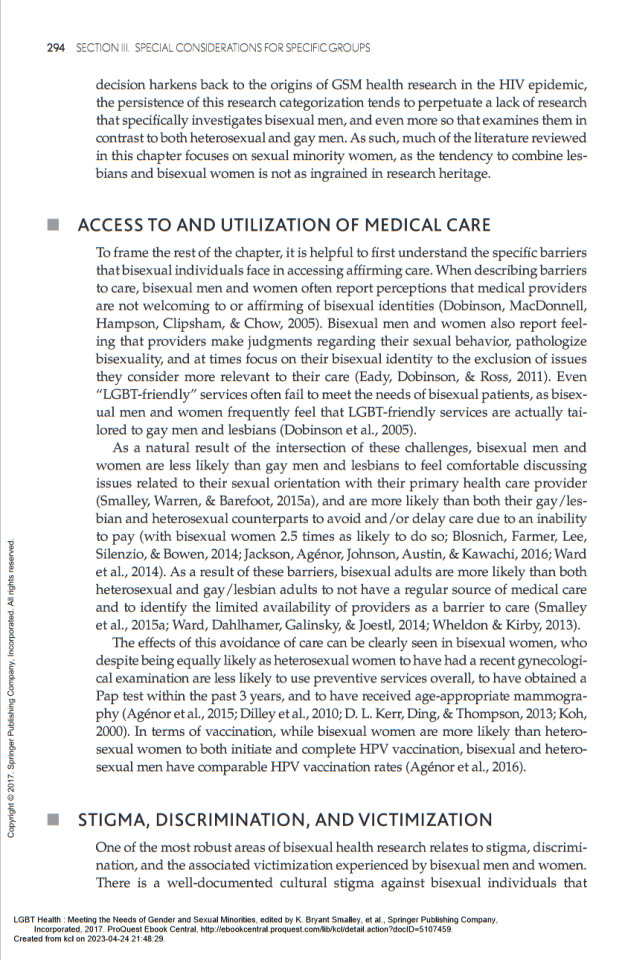
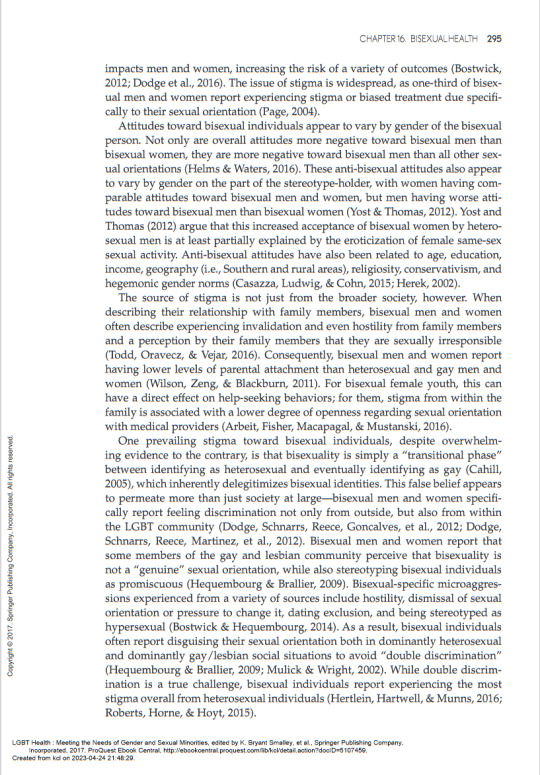

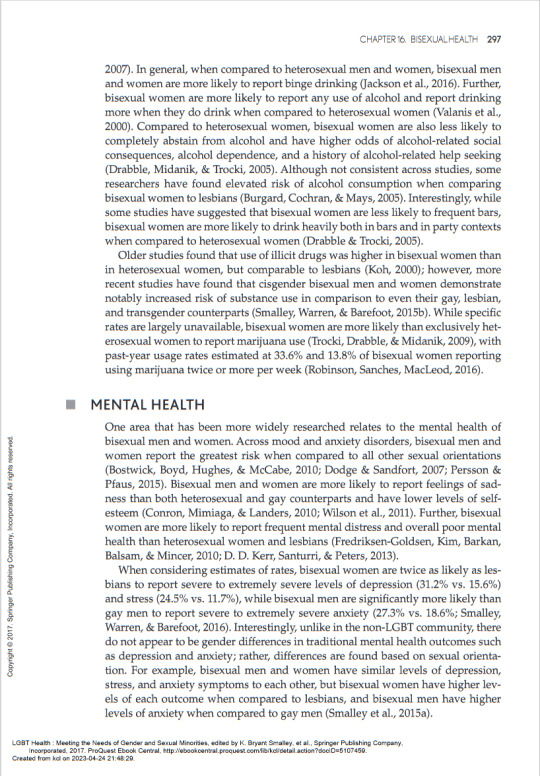

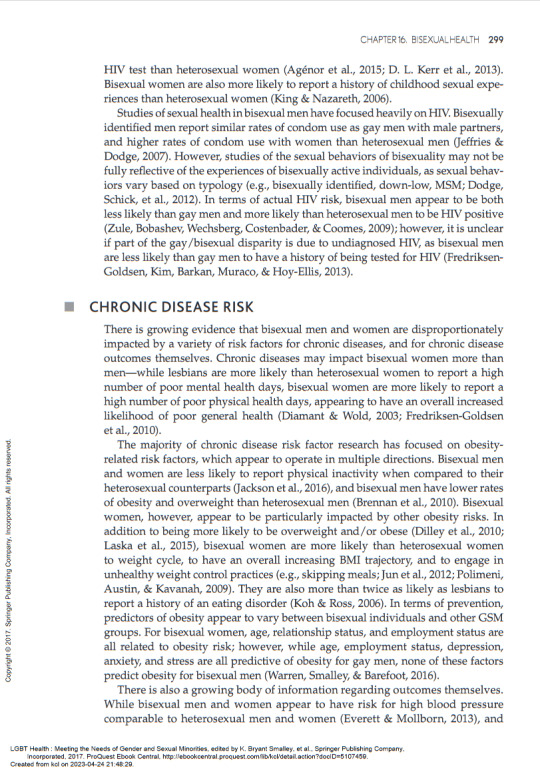
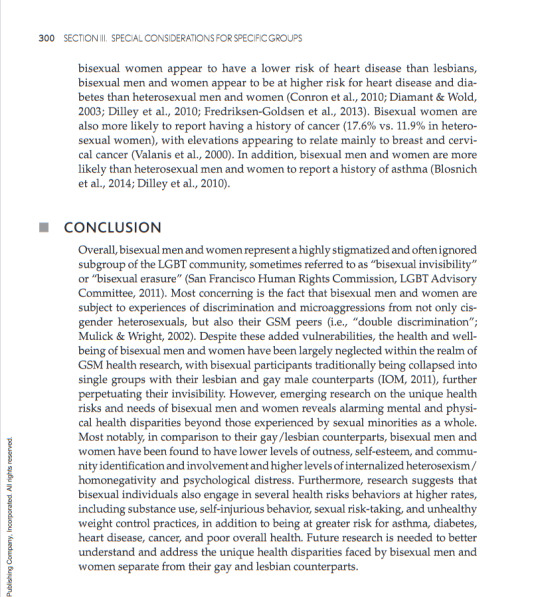
268 notes
·
View notes
Text
Originally posted Jan 2023.
The medical community and the media hang their hats on the use of ‘double-blind, placebo-controlled, peer-reviewed studies published in legacy journals such as The New England Journal of Medicine (NEJM) and the Journal of the American Medical Association (JAMA). In a future substack, I will go into detail about the fallacies, and even the scam, of peer review and why it should not be held out as sacrosanct.
For today’s discussion, let’s examine why all vaccine research should be questioned. Yes, ALL of it. If you read enough studies, you’ll see the patterns described below. For this substack, I’ll use this study on the safety of hepatitis B vaccination in children in India as an example. The vaccine used, Revac-B, contained both 0.5mg of aluminum and 0.05 mg of thimerosal, considered to be safe.
1. Vaccine trials can be quite small and include only healthy children.
Every study begins with ‘selection criteria’ that describe including only healthy individuals. This is from the hepatitis B study example:
All 60 subjects included in the study were in good health and had a negative history of hematological, renal, hepatic, or allergic diseases. All were screened and found to have normal blood panels, including normal liver enzymes.
When a vaccine trial has been completed and the vaccine is approved for use by the FDA, the vaccine is recommended for ALL children, regardless of their health condition, family history, or genetics. In fact, the new shot is most ardently pushed on children with underlying health concerns, such as seizure disorders, cardiac anomalies, and conditions such as cystic fibrosis or Down’s syndrome. These children become the next round of experimentation because the vaccines were never tested for safety on these groups and others.
2. Vaccine studies follow side effects for a short period of time.
Most clinical trials monitor for side effects for a paltry 21 days, often less. In some studies, such as in the example we are using, children were monitored for 5 days by study monitors and 5 days by cards given to parents. If no reactions occur, the shot is deemed to be ‘safe.’
However, it can take weeks to months for immune and neurological complications to appear. These arbitrary deadlines, allowed by the FDA, prohibit making the connection between vaccines with chronic health disorders. If an illness emerges later, of course, the doctors will say it has nothing to do with the vaccine.
3. Most vaccine safety studies do not use a true placebo.
The gold standard in medical research is the "placebo-controlled" trial. A placebo is an inactive or inert substance, such as a sugar pill or a shot of saline. In the trial, the placebo is given to one group, while the treatment group is given the experimental product. The placebo arm is used to ‘blind’ the study so the investigator doesn’t know if the subject received the Real Thing or the Inert Substance to minimize interpretation bias.
When reading a published vaccine trial, the substance used as the placebo is often not identified; it is simply called ‘placebo.’ For example, in this study for a new hepatitis B vaccine to treat chronic hepatitis B, the word ‘placebo’ is used 22 times, but we don’t know what placebo was used.
And that’s a problem. The substance used as a ‘placebo’ is often not inert; it may even may be another vaccine. For example, I remember reading a study where the meningitis C vaccine was used as a placebo because it was considered to be non-immunogenic and non-reactive. Or, in the instance of the Gardasil (HPV) vaccine, the ‘placebo’ was an injection of aluminum.
All studies for the Gardasil vaccine were said to be placebo-controlled and the total population that received a placebo included 9,701 subjects. The placebo was an aluminum adjuvant in all studies except study 018 (pre-/adolescent safety study), which used a non-aluminum-containing placebo [and we don’t know what that placebo was]
8 notes
·
View notes
Text

Ain’t no pantry like a west coast pantry ‘Cause a west coast pantry don’t stock Heinz
(C•H•B not associated with Chronic Hepatitis B)
17 notes
·
View notes
Text
New Gaza fundraiser asks I've received (25 August)
Ahmed AlSaidi (@supportmyfamily, @ahmed-saidi): Ahmed is raising money to support four families with 8 children (his family including his wife and 3 children, his elderly parents, his brothers and their families). Their house has been destroyed. Many of them, especially the children, have contracted skin diseases and Hepatitis B. His elderly parents also suffer from many illnesses and needs health support. (https://gofund.me/9da4f51b) (verified by @moayesh, see see post here for proof. From my understanding @/moayesh is one of the people running @gaza-evacuation-funds.) (25 Aug: VERY LOW FUNDS: Only £10 raised of £30,000 goal!)
Aya Yasser (@ayayassir): Aya is a 19-year-old uni students specializing in technology, but her uni has been destroyed. Her father is 55 years old and sick but there’s no treatment for him. She is trying to evacuate her family, including herself, her brothers, and eight other people. (https://gofund.me/870a3584) (vetted by association. @/ayayassir is the sister of @/rehamyasirr (campaign shared by 90-ghost). See post here for proof of the two's relations.) (25 Aug: VERY LOW FUNDS! Currently $85 AUD raised of $100,000 goal!!)
Ahmad Waleed (@ahmadwaleed5): Ahmad is 14 years old and dreams of becoming a doctor. (https://gofund.me/944ddd9b) (#167 on the verified fundraiser list by el-shab-hussein and nabulsi)
Nabila Mohammed (@nabila6o): Nabila is 64 years old. He suffers from chronic diseases, high blood pressure and diabetes. He has run out of medication and he cannot feel his limbs most of the time. He is trying to raise money for his medication and for the fees needed to evacuate out of Gaza. (https://gofund.me/39c2807d) ( shared by 90-ghost)
Click here for my Masterlist for fundraisers from 13 July - 25 July.
Click here for my Masterlist for fundraisers from 26 July -29 July.
Click here for my Masterlist for fundraisers from 30 July - 1 August.
Click here for my Masterlist for fundraisers from 2 August - 5 August.
Click here for my Masterlist for fundraisers from 6 August - 10 August.
Click here for my Masterlist for fundraisers from 11 August - 14 August.
Click here for my Masterlist for fundraisers from 15 August - 18 August
Click here for my Masterlist for fundrasiers from 19 August - 21 August
Click here for my Masterlist for fundrasiers from 22 August - 24 August
How does vetting and verification work? See post here. (also read comments regarding 90-ghost and why we trust the campaigns he has shared)
Click here for my Google Doc with my complete masterlist of all the Palestinian gfm asks I've received, updated daily (along with other verified ways to send aid to Gaza).
Don't forget your Daily Clicks on Arab.org, it's free!!! and Every click made is registered in their system and generates donation from sponsors/advertisers.)
#palestine#gaza#free gaza#free palestine#post has been vetted and verified#verified#gaza genocide#vetted#donations#fundraising#vetted gfm#vetted campaign#vetted fundraisers#vetted gofundme#verified fundraiser#verified gofundme#gaza fundraiser#gaza gofundme#palestine gofundme#palestine fundraiser#gaza gfm#palestine gfm#new ask#new asks#25 august
6 notes
·
View notes
Text
Understanding Liver Disease Causes, Symptoms, and Treatments in Bangalore
Liver is an important organ among many involved in providing many vital functions in the body such as detoxification, metabolism and nutrient storage. Nevertheless, several conditions can induce liver disease, therefore it no longer executes all its vital functions. Living in Bangalore and caring about your liver health means that you need to know the reasons, manifestation signs, and existing treatments for the liver diseases.
Understanding Liver Disease:
Liver disorders present a broad spectrum of conditions that damage the liver parenchyma and its capacity. Hepatitis, fatty liver disease, cirrhosis, and liver cancer are the most known liver diseases. Such conditions can be caused by viral infections, alcohol abuse, obesity, autoimmune disorders, genetic factors, and exposure to toxins and medications to begin with.
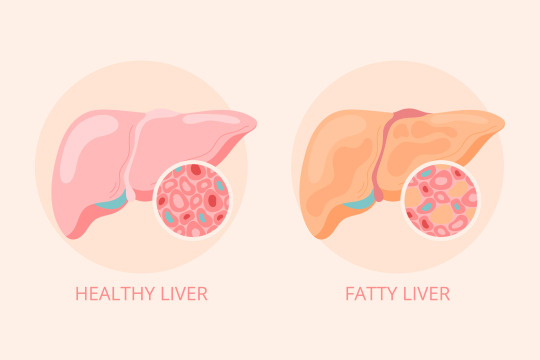
Causes of Liver Disease:
Viral Hepatitis: Hepatitis viruses, including hepatitis A, B, and C, can cause inflammation and damage to the liver. These viruses are typically transmitted through contaminated food or water (hepatitis A), blood or bodily fluids (hepatitis B and C), or sexual contact.
Alcohol Abuse: Excessive alcohol consumption over time can lead to alcoholic liver disease, characterized by inflammation, fatty deposits, and scarring of the liver (cirrhosis). Alcohol-related liver disease is a significant cause of liver-related morbidity and mortality worldwide.
Non-Alcoholic Fatty Liver Disease (NAFLD): Non-Alcoholic Fatty Liver Disease is a condition characterized by the accumulation of fat in the liver, not caused by excessive alcohol consumption. Risk factors for Non-Alcoholic Fatty Liver Disease include obesity, diabetes, high cholesterol, and metabolic syndrome.
Autoimmune Liver Diseases: Conditions such as autoimmune hepatitis, primary biliary cholangitis, and primary sclerosing cholangitis occur when the body's immune system mistakenly attacks the liver, leading to inflammation and damage.
Genetic Disorders: Inherited liver diseases, such as hemochromatosis, Wilson's disease, and alpha-1 antitrypsin deficiency, can affect liver function and lead to complications if left untreated.
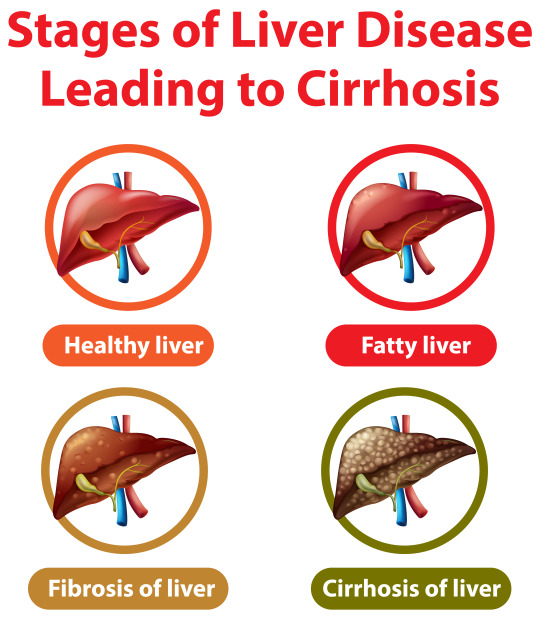
Symptoms of Liver Disease:
The symptoms of liver disease can vary depending on the underlying cause and severity of the condition.
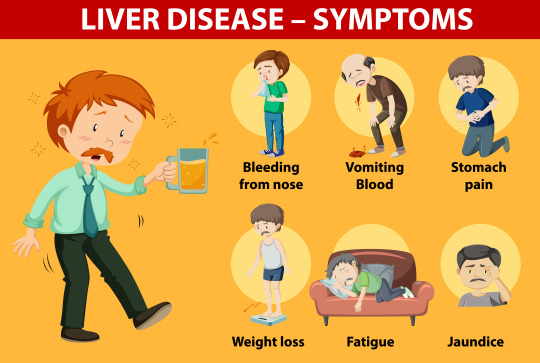
Common symptoms may include:
Fatigue
Jaundice (yellowing of the skin and eyes)
Abdominal pain or swelling
Nausea and vomiting
Loss of appetite
Unexplained weight loss
Dark urine
Pale-colored stools
Easy bruising or bleeding
Swelling in the legs and ankles (edema)
Mental confusion or cognitive impairment
Seeking Treatment in Bangalore:
Fortunately, Bangalore boasts world-class healthcare facilities and a network of experienced hepatologists and gastroenterologists specializing in liver disease diagnosis and management. If you're experiencing symptoms of liver disease or have concerns about your liver health, seeking prompt medical attention is crucial.
Diagnostic Tests:
Upon consultation with a healthcare provider, diagnostic tests may be performed to evaluate liver function and identify the underlying cause of liver disease. These tests may include blood tests to assess liver enzyme levels, imaging studies such as ultrasound or MRI, and liver biopsy for tissue analysis.
Treatment Options:
Lifestyle Modifications: For certain liver diseases, lifestyle changes such as abstaining from alcohol, adopting a healthy diet, maintaining a healthy weight, and exercising regularly can help slow disease progression and improve liver health.
Medications: Depending on the underlying cause of liver disease, medications may be prescribed to manage symptoms, reduce inflammation, or treat underlying infections. In the case of viral hepatitis, antiviral medications may be used to suppress viral replication and prevent liver damage.
Liver Transplantation: In advanced cases of liver disease, such as end-stage liver failure or liver cancer, liver transplantation may be considered as a life-saving treatment option. Bangalore is home to reputable transplant centers offering state-of-the-art surgical procedures and post-transplant care.
Supportive Therapies: Additional supportive therapies, such as nutritional counseling, vitamin supplementation, and management of complications like ascites or hepatic encephalopathy, may be recommended to improve quality of life and overall well-being.
Empowering Patients Through Education and Support:
Living with liver disease can be challenging, but patients in Bangalore have access to a supportive network of healthcare professionals, patient advocacy groups, and educational resources. These resources can provide valuable information, emotional support, and practical guidance to help patients navigate their liver disease journey with confidence and resilience.
Diagnosed with liver disease treatment in Bangalore will be easily accessible, due to the city's advanced infrastructure for healthcare and highly skilled personnel. Through the realization of the causative factors, recognition of symptoms and prompt medical treatment, the individuals would be able to respond to the advancement of liver health and possibly subsidize the influence of liver disease on their lives. Patients in Bangalore have a secure platform to practice a healthy life or even medical treatments and transplant options when they require such care and support at any point of the way If you are suffering from the signs of liver disease or your loved one is showing them, do not hesitate reaching a health care provider in Bangalore to have a personal evaluation and get treatment. First and foremost, your liver health matters, and with appropriate care and support, it is possible to take back your life and enhance your general well-being.
So for the sake of studies, these details are for educational purposes only. If you have to get engagements about diagnoses and surgeries, you can speak first at the hospitals or the clinics by yourself from specialists.
#Hepatitis b treatment in Bangalore#Chronic Hepatitis b treatment in Bangalore#Hepatitis C treatment in Bangalore#Hepatitis A treatment in Bangalore#Hepatitis E treatment in Bangalore#fatty liver treatment in Bangalore#Liver inflammation treatment in Bangalore#Liver disease treatment in Bangalore#Liver#hepatitis#livercare#clinics#hospitals
1 note
·
View note
Text
𝘼-𝙕 𝙇𝙄𝙎𝙏 𝙊𝙁 𝘿𝙄𝙎𝙀𝘼𝙎𝙀𝙎/𝙄𝙇𝙇𝙉𝙀𝙎𝙎𝙀𝙎 𝙁𝙊𝙍 𝙎𝙄𝘾𝙆𝙁𝙄𝘾/𝙒𝙃𝙐𝙈𝙋
— A
Anemia.
Adenomyosis.
Asthma.
Arterial thrombosis.
Allergies.
Anxiety.
Angel toxicosis ( fictional ).
Acne.
Anorexia nervosa.
Anthrax.
Atma virus ( fictional ).
ADHD.
Agoraphobia.
Astrocytoma.
AIDS.
— B
Breast cancer.
Bunions.
Borderline personality disorder.
Botulism.
Barrett's esophagus.
Bowel polyps.
Brucellosis.
Bipolar disorder.
Bronchitis.
Bacterial vaginosis.
Binge eating disorder.
— C
Crohn's disease.
Conjunctivitis.
Coronavirus disease.
Coeliac disease.
Chronic migranes.
Coup.
Cushing syndrome.
Cystic fibrosis.
Cellulitis.
Coma.
Cooties ( fictional ).
COPD.
Chickenpox.
Cholera.
Cerebral palsy.
Chlamydia.
Constipation.
Cancer.
Common cold.
Chronic pain.
— D
Diabetes.
Dyslexia.
Dissociative identify disorder.
Dengue fever.
Delirium.
Deep vein thrombosis.
Dementia.
Dysthimia.
Diphtheria.
Diarrhoea.
Disruptive mood dysregulation disorder.
Dyspraxia.
Dehydration.
— E
Ebola.
Endometriosis.
Epilepsy.
E-coli.
Ectopic pregnancy.
Enuresis.
Erectile dysfunction.
Exzema.
— F
Fusobacterium infection.
Filariasis.
Fibromyalgia.
Fascioliasis.
Fever.
Food poisoning.
Fatal familial insomnia.
— G
Gonorrhoea.
Ganser syndrome.
Gas gangrene.
Giardiasis.
Gastroesophageal reflux disease.
Gall stones.
Glandular fever.
Greyscale ( fictional ).
Glanders.
— H
Hookworm infection.
Hand, foot and mouth disease.
Hypoglycaemia.
Herpes.
Headache.
Hanahaki disease ( fictional ).
Hyperhidrosis.
Heat stroke.
Heat exhaustion.
Heart failure.
High blood pressure.
Human papillomavirus infection.
Hypersomnia.
HIV.
Heart failure.
Hay fever.
Hepatitis.
Hemorrhoids.
— I
Influenza.
Iron deficiency anemia.
Indigestion.
Inflammatory bowel disease.
Insomnia.
Irritable bowel syndrome.
Intercranial hypertension.
Impetigo.
— K
Keratitis.
Kidney stones.
Kidney infection.
Kawasaki disease.
Kaposi's sarcoma.
— L
Lyme disease.
Lassa fever.
Low blood pressure.
Lupus.
Lactose intolerance.
Lymphatic filariasis.
Leprosy.
— M
Measles.
Mad cow disease.
Mumps.
Major depressive disorder.
Malaria.
Malnutrition.
Motor neurone disease.
Mutism.
Mouth ulcer.
Monkeypox.
Multiple sclerosis.
Meningitis.
Menopause.
Mycetoma.
— N
Norovirus.
Nipah virus infection.
Narcolepsy.
Nosebleed.
Nocardiosis.
— O
Obsessive-compulsive disorder.
Osteoporosis.
Ovarian cyst.
Overactive thyroid.
Oral thrush.
Otitis externa.
— P
Pancreatic cancer.
Pneumonia.
Pelvic inflammatory disease.
PICA.
Premenstrual dysphoric disorder.
Psoriasis.
Parkinson's disease.
Panic disorder.
Polycystic ovarian syndrome.
Plague.
Postpartum depression.
Pediculosis capitis.
Psychosis.
Post-traumatic stress disorder.
— Q
Q fever.
Quintan fever.
— R
Rubella.
Rabbit fever.
Rotavirus infection.
Ringworm.
Restless legs syndrome.
Rhinovirus infection.
Rosacea.
Relapsing fever.
Rheumatoid arthritis.
Rabies.
— S
Shingles.
Sore throat.
Stutter.
Separation anxiety disorder.
Smallpox.
Scoliosis.
Septic shock.
Shigellosis.
Sepsis.
Social anxiety disorder.
Stroke.
Scarlet fever.
Schizophrenia.
Sleep apnea.
Sun burn.
Syphilis.
Sickle cell disease.
Scabies.
Selective mutism.
Salmonella.
Sensory processing disorder.
— T
Thyroid cancer.
Tuberculosis.
Thirst.
Trichuriasis.
Tinea pedis.
Tourette's syndrome.
Trachoma.
Tetanus.
Toxic shock syndrome.
Tinnitus.
Thyroid disease.
Typhus fever.
Tonsillitis.
Thrush.
— U
Urinary tract infection.
Underactive thyroid.
— V
Valley fever.
Vertigo.
Vomiting.
— W
White piedra.
Withdrawal.
Whooping cough.
West nile fever.
— X
Xerophthalmia.
— Y
Yersiniosis.
Yellow fever.
— Z
Zygomycosis.
Zika fever.
Zeaspora.
21 notes
·
View notes
Note
delete this please I have depression, anxiety, panic, post traumatic stress disorder, psychosis, high blood pressure, low blood pressure, hpv, hiv, dengue, zika, chikungunya, black plague, polio, infantile paralysis, osteoporosis, swine flu, yellow fever, meningitis, meningitis b, gonorrhea, herpes, pharyngitis , Chagas disease, bronchitis, leptospirosis, cancer, measles, chickenpox, smallpox, mumps, gastritis, tetanus, hepatitis, conjunctivitis, stroke, whooping cough, labyrinthitis, scabies, leukemia, rabies, cirrhosis, scoliosis, microcephaly, anencephaly, ebola, ingrown toenail, autism, asperger's syndrome, arrhythmia, pneumonia, diabetes(type 1 and 2), heart failure, petho envy, dwarfism, gigantism, down syndrome, asthma, liver cancer, esophageal cancer, brain cancer, stomach cancer, skin cancer , leprosy, homosexuality, herniated disc, thrombosis, elephantiasis, passion fruit heel, phimosis, prostate cancer, testicular cancer, parkinson's disease, headache, malformation of the ovaries, lymphoma, lead poisoning, severe allergies, endometriosis, stomach ulcers, irritable bowel syndrome, appendicitis, chronic migraines, graves disease, blindness, deafness, stage 4 kidney disease, organ failure, 90% stage 3 burn, urinary tract infection, cervical cancer, uterine tuberculosis, uterine fibroids, uterine prolapse, anal prolapse, hemorrhoids, dermatillomania, coronavirus, contact dermatitis, eczema, athletes foot, fungal infection, bacterial infection, and veganism
Have you tried yoga.
11 notes
·
View notes